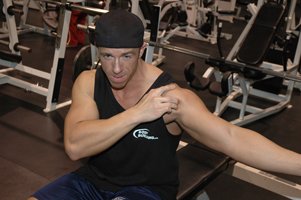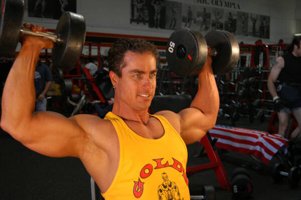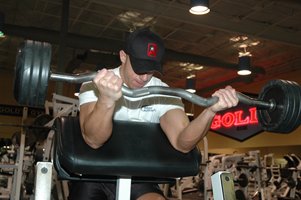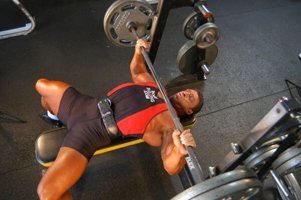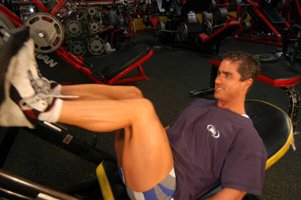Get Your Priorities Straight!
Wouldn't it be nice to have a huge, barrel-like chest, massively peaked biceps, and flaring wide front deltoids? Of course it would! What if in exchange for all that you are stuck with: you have a shallow back, flat triceps, nonexistent side and rear deltoids and stick legs. That doesn't sound too appealing anymore does it?
On your quest to build a solid, proportioned physique, you must first build a foundation of balanced muscularity through your best efforts.
After some time of toiling away in the gym you will find some body parts do not respond as well as others; you may be lacking mass in certain areas that need some extra attention. Trust me you are not alone.
Bodybuilding is a tough, sometimes thankless effort that demands dedication, discipline, and consistency. Even some of the most dedicated, hardworking individuals will put in countless hours of blood sweat and tears and still walk away with very minuscule gains in muscle mass.
In order to avoid the abyss of becoming disproportionate you must utilize a simple but infrequently used method in the gym: Prioritizing. That is to focus on a weak point and put it at the top of your "to do" list.
How many trainees do you see enter a gym on a Monday and go straight for the flat bench press? These same individuals have weak upper chests, little shape in their pectorals and probably experience some pain in their shoulders.
Additionally they do countless sets of bench, incline, and decline presses, flyes, dumbbell presses, and cable cross-overs while reserving a day later in the week for a few pitiful sets of squats, leg extensions and leg curls—oh, and a set or two for calves if they have time.
As mentioned earlier, some areas may not respond as quickly as others. You may have a well developed upper body while you struggle to gain an ounce of muscle in your legs or you may have a great chest with a weak back, or any other combination of deficiencies.
While not a huge believer in giving genetics as an excuse entirely I feel it does unfortunately play a role in the rate of development of a certain area.
Another factor to consider is experience. Allow me to explain utilizing an example: I had a friend Thayer (we called him Tyson due to his resemblance to the boxer) who did push-ups and dips every single night when he was a teenager along with weekly workouts for chest and arms.
By the time he was 20 his chest and triceps were absolutely massive, striated, and completely developed. The reason? He created very intense and thorough nerve innervations in those areas by constantly creating an active environment of protein synthesis, lactic acid, and the mind-muscle connection.
Was it genetics? Who knows, but just by the simple fact that so much attention was paid to those areas and the nervous system had such an easy connection to his chest and triceps he was able to do just a few pump up sets and his chest and arms would pump up with enormous amounts of blood.
Another well-known example is of Arnold Schwarzenegger's calves. When he came to America in late 1968 his calves were lacking development as so much attention was given to his upper body.
He began dedicating 45 minutes per day for a total of 500 hours over a 2 year period to prioritizing his calves. The results were some of the best calves in the sport of bodybuilding.
Now, I am not advising going to these extremes in regard to prioritizing your weak points, but you can take calculated steps to improve their development.
Prioritizing does not require hours of extra time in the gym or monopolizing numerous pieces of equipment; what it does call for is careful planning and the right mindset.
There are many techniques to choose from in your arsenal to do battle with those stubborn weak areas but you must keep in mind that to truly improve the development of certain areas requires the utmost focus and belief that it can improve.
Without those factors in check you will guarantee your unfulfilled potential. So put these techniques to good use and tweak them to fit your priorities.
Top Ten Priorities List
1. Prioritize Sequence
This simply means to place weak body parts at the beginning of your workout so that they may be trained when your energy is the highest. This will ensure that that area will get the most intensity applied to it without being too tired if you were to train it towards the end of your workout.
For example: If you have weak calves, work them before thighs. If you have weak triceps, train them before biceps.
One thing to keep in mind is to try to avoid training weak links to other muscles first. For example: do not work shoulders or triceps before chest, and biceps before back. This will result in your arms being too tired to have an effective chest or back workout.
Another factor to consider is to place weak points earlier in the week as well. If your training regimen calls for taking the weekends off, training weak areas will be more effective after a couple of rest days.
2. Increase Frequency
Another popular, but sometimes abused, method is increasing the number of times a weak point is trained per week. This does not imply training that certain area every single day, but possibly every other day or three times per week.
This method is usually reserved for smaller body parts such as calves, but it can be applied to larger areas with modification.
For example: if your upper chest is lacking development, simply perform your regular chest workout early in the week prioritizing upper pecs and then later in the week designate a day to doing just a few extra sets for that area. This way you will not run the risk of overtraining with too much volume on both days.
Again, try not to over do it. Normally an extra few sets per week is all you need for this method to be effective.
3. Pre Exhaust
This tried and true principle is extremely useful for larger body parts that require numerous compound movements. Some trainees may not feel the bench press in their chest very much or they may not really work their thighs thoroughly with squats, instead they feel their hips, glutes, and hamstrings.
Pre exhausting that area can solve these problems two-fold:
- Performing leg extensions, for example, prior to squats or leg presses will force the actual quads to work harder.
- You will create new nerve activity in that area you are targeting and strengthening the mind-muscle connection. You will be more in-tune to the specific area so as you go back to a more traditional regimen you will be better connected to that area.
Some other examples include flyes before bench presses, dumbbell pull-overs before rows, side laterals before overhead presses, and leg curls before stiff-legged deadlifts.
4. Compound Sets
Compound sets are simply a type of superset where two sets for the same body part are performed back-to-back. This compound set can be performed with two different movements or with the same movement (this would be referred to as a strip set or drop set).
For example: you could perform incline bench dumbbell curls and then immediately do a set of standing barbell curls.
An example of a strip set is doing a set of leg extensions at a certain weight, then when you have reached failure take between 10 to 20 percent of the weight off and continue your set. This may go on for two or more sets until the muscle being worked is completely spent!
5. Staggered Sets
This technique is great to use when time is not on your side, but will help with your conditioning as a side effect. A staggered set means just that; you stagger in a weak point movement while you are supposed to be resting during a normal workout.
Let's say you are working chest and you want to bring up the development of your calves. After doing a set for chest, instead of resting, throw in a set of calves in between. By the time your chest workout is complete you will have done a good number of sets for calves all the while spending no more time in the gym.
6. Heavy Reps
Sometimes you just need to pile on the weight and punish that weak point. Load the bar with more weight than you are accustomed to and go down to 4, 3 or even two reps on some sets.
Sometimes a weak point needs to feel a heavy load to bust through a plateau. Of course you want to perform these reps with utmost form and safety. Heavy reps will do little for muscle mass gain, but the strength side effect will enable you to lift heavier when you return to your normal routine.
7. High Reps
Maybe that pesky weak point needs to be pummeled with some high reps; not just 15, 20, or 25 reps, but more like 40, 50, or more! This is especially effective for lower body training as legs can sometimes be made of those stubborn slow-twitch fibers.
Also, this technique gives you the opportunity to create those strong nerve innervations and develop more of the mind-to-muscle connection. Try doing a few sets of 30 reps or so at the end of a normal routine.
For example: for calves do your regular routine and then jump on a leg press machine and rep out. Using a machine (specifically one where you sit) will ensure you will not have any balance issues.
If you find yourself getting tired in the middle of your set rest in the bottom position for a count of five or ten and then continue. Try to focus on the burn and blast through those plateaus!
8. Partials
Powerlifters often utilize partials in there training to bust through plateaus and move upwards with their loads. Bodybuilders can benefit from this technique as well.
Simply put, a partial is continuing part of the movement after you have reached failure on the full range of motion. This partial movement can be performed at the bottom, top, or middle of the movement.
Some are easier than others, so the type of movement will sometime dictate where to perform the partial. A leg press partial usually is done near the top of the movement.
After you have reached absolute muscular failure with full range reps, do a few half rep partials from about half way down and then press back to contraction. Find where the partial can be performed with safety for each movement after you have reached failure with full reps.
9. Holds
Do you want to look weird in the gym? Try doing holds and see how many odd looks you get. A hold is a great way to condition the body for greater loads. It is a sneaky way to get a muscle group to adapt to a new weight without actually moving the weight.
For example: for squat holds load the bar with more weight than you can actually rep with, maybe enough for a one rep max. Take the weight off of the rack, step back, and then get into the starting squat position with your legs slightly bent. Keep your body tight and let it feel the heavy load and hold it for a count of 10, 20, or 30 seconds.
In other words, you are just letting your body feel a heavy load so it may adapt somewhat. One word of caution; do not lock out your joints on any hold. Keep your joints slightly bent so the muscle will bear the load.
10. Use Bodybuilding.com
Bodybuilding.com has a vast amount of information and interactive tools to help you on your quest to build an impressive physique. Whether it is creating a BodySpace, writing down your thoughts in a BodyBlog, or keeping track of every single set and rep on the Workout Tracker Bodybuilding.com has you covered.
Additionally, you have access to many other bodybuilders and workout enthusiasts by jumping on the Forums. Pick their brains, exchange routines, diet plans, and techniques, and start to formulate your own unique plan of action.
Conclusion
These are just a few methods you can include in your arsenal to build your ultimate physique. Try these techniques for just two or three weeks at a time as they can be intense and could cause overtraining if used for too long. Good luck!

